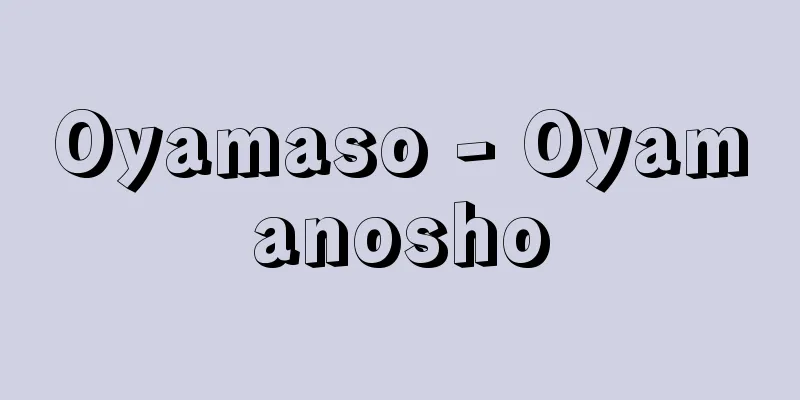Oyamaso - Oyamanosho

|
From the Heian to Muromachi periods, the Toji estate was located in Taki District, Tanba Province (Sasayama City, Hyogo Prefecture). Control of Oyama Manor within Toji Temple was initially held by the Denbo Kuke family, but by the end of the Heian period it had passed to the Choja family, and by the end of the Kamakura period it had passed to the Shigyo family, and then to the Guso family. Oyama Manor is thought to have been established in 845 (Jowa 12) as a Kansho Fusho manor, which was granted the privilege of exemption from government property under the Dajo Kanfu and Minbu Shofu. Later, while Toji Temple tried to secure land for itself, the Kokuga (provincial government office) made all land except for the currently used land publicly and collected government property from them, so for a time it lost its status as a manor, but in the Otoku period (1084-1087) when the Toji Temple pagoda was restored, land was set aside to cover the cost of offerings to the Buddha, and in 1102 (Kōwa 4) Oyama Manor was rebuilt as an ichien domain exempt from government property and miscellaneous duties. In the Kamakura period, after the Jōkyū War, the Nakazawa clan was appointed as land steward and expanded their influence, so in 1241 (Ninji 2) the manor became a land steward, and in 1295 (Einin 3) the land was divided into two parts. From then on, Toji and the Jito divided their lordship and ruled separately. In 1318 (Bunpo 2) at the end of the Kamakura period, the peasant contract (jigeuke) was established in Ichiidani within the manor, where peasants directly contracted to pay annual taxes to the lord. During the Nanboku-cho and Muromachi periods, peasants fought against the manor lords based on this kind of village association, while the power of the shugo (military governor) advanced in the levy of half-tax and shugoyaku (military governor's duties) on the manor. Toji maintained control over the manor by employing deputies, but in the Eisho period (1504-1521), Oyama Manor came under the control of the Hatano clan, a local lord in Tanba, and disappeared. [Toshiko Ito] [Reference items] | |Source: Shogakukan Encyclopedia Nipponica About Encyclopedia Nipponica Information | Legend |
|
平安時代から室町時代にかけて丹波(たんば)国多紀(たき)郡(兵庫県丹波篠山(ささやま)市)に置かれていた東寺領荘園。東寺内部における大山荘支配権は、当初は伝法供家(でんぼうくけ)が握っていたが、平安末期には長者(ちょうじゃ)、鎌倉末期には執行(しぎょう)、ついで供僧(ぐそう)へと移った。大山荘は845年(承和12)太政(だじょう)官符、民部省符によって所当官物(しょとうかんもつ)免除の特権を与えられた官省符荘(かんしょうふしょう)として成立したと考えられる。その後、東寺が荘田を確保しようとするのに対して、国衙(こくが)は現作田を除く荘田を公田化して官物を徴収したため、一時は荘園としての実体を失ったが、応徳(おうとく)年間(1084~1087)の東寺塔復旧に際し、その仏供料(ぶっくりょう)などを負担する田地が設定されたことを契機として、1102年(康和4)に大山荘は官物雑役(ぞうやく)免除の一円領として再建された。鎌倉期には、承久(じょうきゅう)の乱後、荘地頭職に中沢(なかざわ)氏が補任(ぶにん)されて勢力を伸ばしたため、1241年(仁治2)に当荘は地頭請(じとううけ)となり、さらに1295年(永仁3)には下地中分(したじちゅうぶん)が行われた。以後東寺方と地頭方とは領主権を分かち、別個に支配が行われることになる。すでに鎌倉末期の1318年(文保2)に当荘内の一井谷(いちいだに)では、年貢納入を百姓が領主に対して直接に請け負う百姓請(地下請(じげうけ))が成立しているが、南北朝・室町期には、このような村落結合を基盤とした農民の対荘園領主闘争が展開し、一方、半済(はんぜい)や荘への守護役(しゅごやく)賦課などに守護勢力の進出がみられる。これに対し、東寺は代官を採用することにより荘支配を維持していたが、永正(えいしょう)年間(1504~1521)に、大山荘は丹波土豪波多野(はたの)氏の勢力下に入り消滅するに至った。 [伊藤敏子] [参照項目] | |出典 小学館 日本大百科全書(ニッポニカ)日本大百科全書(ニッポニカ)について 情報 | 凡例 |
>>: Lynx (Lynx) - Lynx (English spelling)
Recommend
Atsumi Bay
The eastern sea area of Mikawa Bay in the south...
Large sesame grass - Large sesame grass
This butterfly belongs to the order Lepidoptera, ...
Jackson, Andrew
Born March 15, 1767 in Waxhaw, South Carolina [Die...
Hallway - Hallway
A long, narrow space that connects two or more ro...
Charge transfer - Denkaido
The phenomenon in which electrons move from one at...
Kuwago (Mulberry Wild Silkworm)
An insect of the family Bombycidae in the order Le...
Winter Day - Fuyunohi
A collection of haiku poems. One volume. Compiled...
QWL - Quality of working life
Also known as quality of working life, this is a g...
ludus
…Both the syllabus and preface contain the meanin...
Meimuna boninensis (English spelling)
…Cicada [Masami Hayashi]. . … *Some of the termin...
Ehime iris
A perennial plant of the Iridaceae family that gro...
Gǔ Yŏng (English)
? - Front 8 A Chinese politician during the reign ...
Obsidian - kokuyouseki (English spelling) obsidian
A glassy volcanic rock with almost the same chemi...
Standing - Tachimawari
1. To walk around from place to place. Also, to st...
Happy Light - Kouyoshimitsu
Born: November 16, 1892 in Tokyo, Japan [Died] Apr...









